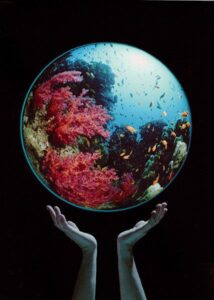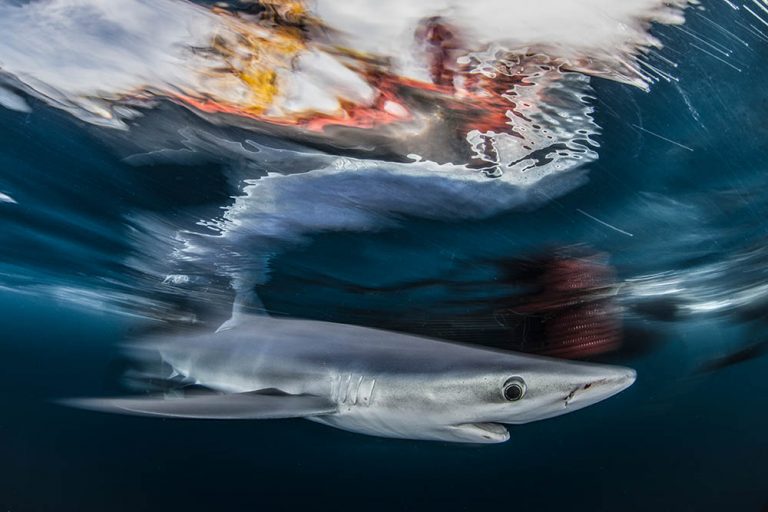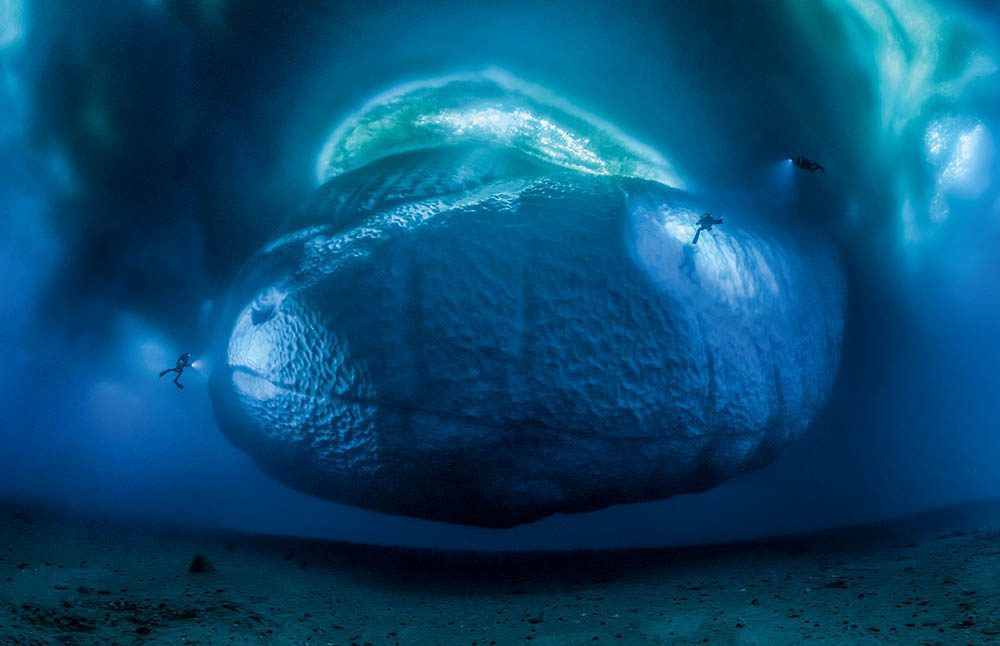PHOTO DIVER
In Search of Perfection
Underwater photographers continue their unending quest for the perfect shot – so how close did the BSoUP Prints competitors get?

WHAT MAKES A GREAT underwater photograph? The British Society of Underwater Photographer Print Competition, sponsored each year by DIVER Magazine, is a contest that can offer clues.
A panel of three judges make an initial selection of what they consider the best entries, and these are displayed at the Dive Show at the NEC, Birmingham. They also select an outright winner and runner-up and confer a number of highly commended accolades.
While the photographs are on display, Show visitors are encouraged to act as judges and their selections determine the winners and runners-up in four categories in the separate Public Vote.
Underwater photographers often find judges’ comments helpful, not only for winning competitions but simply in boosting the quality of their photography. So here is a selection of comments on winning and highly commended images from judges Martin Edge, divEr Publisher Nigel Eaton and BSoUP Chairman Paul Colley, who also chaired the panel.
The judges thought the competition was of a very good standard overall, with some outstanding images at the high end.
They did however point out that some otherwise excellent submissions were let down slightly by basic errors including, but not limited to: framing (most often too tight); sensor dust spots and backscatter that could have been processed out within the rules; blown highlights (pure white with no detail where the composition demanded it); cluttered compositions, most often too much background or other distracting detail; lack of contrast; overprocessed images (too much contrast or unnatural colours); and errors in lighting (such as harsh shadows in an image where the intention was very obviously full lighting of the subject, or subject eyes in deep shadow on head-on shots).
Appeared in DIVER February 2018
Blue Shark, by Nick Moore (Judges’ Choice: Overall Winner)
“While judges are inevitably becoming saturated by exposure to blue-shark images, and it’s now tempting to just admire them and pass by, the right image will still stop you in your tracks.
“This was one of them. The image of the shark itself is impressive enough, with razor-sharp detail and perfectly controlled exposure. But these days that is not enough to win, and the photographer knew this before he got into the water.
“He was willing to risk many unsuccessful shots during these rare and expensive encounters by using a less-predictable but high-payoff technique. As a result, he has rendered the surface and above-water detail in a way that supports the overall story and composition.
“Those who know the set-up can work out that the dive-boat is in the picture, but the slow shutter reduces it to subtle and very attractive colour accents. The result is an extra splash of colour and movement, which supports and balances the picture of a sleek predator racing through the surface of the water. An outstanding piece of underwater art – we just loved it.”
AS THE NORTH SEA oil industry began to open up in the 1970s, Scoones turned his talent to engineering deepwater inspection cameras. He teamed up with young entrepreneur Peter Rowlands, who had recently set up Ocean Optics to sell underwater camera equipment.
With Scoones manufacturing his Underwater Visual Systems equipment for the rigs and Rowlands marketing them, the alliance proved formidable.
Fiona managed to get her hands on a newly released and very expensive Olympus camera. Incautiously leaving it with her dad, she went out. When she returned, the camera was in pieces as he probed its inner workings.
Impressed, he chose to build his MD600 commercial housing around it. This quickly became the industry standard for commercial diving. Rated to 600m, it was mountable on a sub or ROV for surveying where divers could not operate.
It had a special lens system to correct for distortion, essential for creating images for critical analysis of welds, for example. And it was point-and-shoot, so a diver had only to press the shutter-release.
“In the mid-80s I spent a lot of time with the Scoones housings, a fantastic piece of kit for commercial divers,“ says professional diver Michael Ross.
“I was often hired as both diver and photo-tech and worked with a number of different systems for sub-sea inspection purposes. I was also a keen diver-photographer in my spare time, and had a collection of Nikonos gear.
“In my opinion, the Scoones system was everything the Nikonos cameras of the day were not; industrial-strength, heavy-duty and simplicity itself for the user.
“Sure, they weren’t sexy with their cylindrical bare-bones appearance, affectionately known as the ‘biscuit tin’ in the trade.
“But possibly the really, really cool thing about the Scoones system is that even after hundreds of hours’ experience I never had a flood – which, sadly, was not the case with my own Nik equipment.”
SHORTLY BEFORE HE DIED, Scoones gave me a unique sub-sea inspection camera. The MD600 is a housing but the MC70-E is a large-format stereo underwater camera system. It’s the only one he built.
Two cameras with hand-crafted mechanisms are used to photograph from very slightly different angles. The stereo image reveals, to the trained eye, detail that a one-dimensional picture cannot.
Usually, to shoot stereo images, two independent cameras are mounted on a bracket. Scoones’ MC70-E is more advanced – the cameras are conjoined.
To my delight, when I spun off the back cover and plugged in the charger, the cameras powered up. Exposure and focus are fixed. The only control is the shutter-release. 70mm film yields far larger negatives than 35mm and the reward is much finer definition.
Scoones used top-of-the line-Schneider wide-angle lenses in the MC70-E.
A disadvantage he needed to overcome is that the superb technical excellence a land-camera lens can achieve is often badly marred by the housing optics. Usually, simple dome-ports are used to correct terrestrial wide-angle lenses for underwater use.
They correct for refraction, meaning that the lens retains its wide-angle field of view instead of narrowing down the way your eyes do behind your face-mask. However, edge detail is often soft.
To correct the Schneider’s to the standard required for inspection work, Scoones once again designed a special underwater corrector, as he had for the MD600. Instead of a basic hemispherical port, two precision-ground lenses are combined. Together, they maintain the lenses’ field of view and solve the problem of poor edge-sharpness.
It’s a heavy, costly perfectionist’s solution. The MC70-E is, I assume, the deepest-rated, most expensive point-and-shoot underwater camera ever made.
Soon the two Peters began looking for a camera to satisfy the demands of professional underwater photographers. They chose the Mamiya RB67, a medium-format studio camera, for three key features.
The film format was as large as you could reasonably handle under water given that, as formats increase in size, so do the camera bodies and lenses, resulting in ever bulkier and heavier housings.
The image produced was rectangular – the “ideal format” for front covers. Many medium-format cameras shoot square images, designed to be cropped to shape later, which sacrifices quality.
The RB67 also had an unconventional focusing arrangement. Usually lenses have a focus-ring built into the barrel that alters the position of the lens elements. The ability to focus close is often restricted unless special macro lenses are used.
The RB67 uses extendible bellows built into the camera body to adjust focus. This enables very close focusing with ordinary lenses, making it especially adept for working with smaller subjects.
Ten RB67 Marine housings were built from aluminium bearing the Ocean Optics, London name. Rowlands described it “as amazingly beautiful“, and indeed it is. It features Scoones’ trademark two-element correction port and a superb viewfinder system. Mamiya of Japan bought one for its own collection.
AROUND THE SAME TIME, the BBC Natural History Unit was planning an unprecedented wildlife series – it wanted to tell the story of evolution in a 13-part show, fronted by David Attenborough and called Life on Earth.
Fiona relates how her father took the call from Attenborough that would change his life. “Dad was an early pioneer of ROVs to carry cameras into the Christmas trees and along the pipelines of oil- and gas-rigs. David’s ambition was to film a coelacanth in the depths of the Comoros. Dad said that his ROV went out on rental only if he went with it!”
On location, the ROV jammed in the reef and was lost. As the crew dejectedly packed up their remaining kit, a fisherman reeled in a coelacanth. Scoones was able to film the animal in the shallows.

The fish kept hanging head-down, which he took as a sign of its impending death, so he kept turning it back to the horizontal. It was only later, when the fish was finally filmed from subs, that it was realised that this was its natural attitude. But Scoones and Life on Earth had scored an incredible world-first for the NHU.
Scoones’ filming career was on the up, but he continued to shoot stills. In 1980, Pentax released a new professional 35mm SLR. The LX was smaller and lighter than its competitors but, for the creative photographer, it also had a hidden advantage. It set a trend for shooting double exposures “in camera”.
This meant shooting two different photographs of different subjects, at different times and often in different locations, on a single negative. A close-up of a small coral might be combined with a wide-angle sunset shot taken from water level. Today, such images can easily be created digitally, but back in the film days they called for phenomenal skill.
“Unlike other cameras the LX was frame-accurate, meaning you could line up the film for the second shot exactly, even if you had unloaded it,” says Warren Williams, a long-time friend of Scoones and an early BSoUP member.
Scoones’ defining double exposure was his entry for the 1986 Blue Dolphin competition. He donated the LX and housing with which I assume he took this photograph to my collection.
Intriguingly, he had adapted a Nikon viewfinder to fit his Pentax. “Scoonsing” became a well-worn term to describe off-the-shelf camera equipment that he had modified or rebuilt to meet his own requirements. Messing with viewfinders was minor league.
For many years, Scoones’ producer at the NHU was Keith Scholey. “Peter’s impact came from a combination of a number of talents rarely found in one person,“ he explains. “It was Peter’s ability to build his own underwater housings, and his sophisticated understanding of electronic cameras, that drove his innovation.”
“In 1988 the BBC made Reef Watch, a highly ambitious live underwater broadcast. Peter housed the TV camera and discovered how electronic cameras could transform underwater photography by balancing the colour in the camera rather than relying on artificial light.
“Soon after, he housed his own electronic cameras and created a completely new ‘look’ for underwater films that has now been adopted by everyone.”
AT A TALK SCOONES GAVE, I remember him casually explaining how he had dived into the innards of an £80,000 Sony broadcast camera to discard part of the Bayer filter to reduce its sensitivity to green.
In the early 1990s, his quest for perfect underwater optics led him to convert Nikonos lenses, designed for the classic Nikon line of underwater film cameras, to work with broadcast video cameras.
It’s no easy task, but, get it right, and the on-screen results are unbeatable.
Dave Blackham is one of the foremost authorities on underwater optics, and knew Scoones well. His company Esprit Film & Television designs and develops some of the most advanced underwater video equipment there is.
“I’d admired Peter Scoones’ work for many years,” he told me. “He was meticulous in everything he did. I remember talking to Peter and saw that he was accumulating several Nikonos lenses in his workshop which he spoke highly of.
“The problem at the time was that most of the cameras in use for broadcast had much smaller sensors than the Nikonos lenses were intended for. Having adapted several sets of Nikonos lenses myself, I can now better appreciate why Peter was well ahead of the curve in this area.
“To get optics optimised on a standard cinema-grade underwater housing, the addition of a dome or flat port in front of a land lens changes its optical characteristics. Most of the problems crop up with wide lenses, and for the most part that’s usually what the underwater cinematographer wants to use.
“If the dome-port is large enough to accommodate the lens, this usually results in a reasonable-to-well-performing solution. Occasionally it’s excellent.
“But whatever solution you end up with, it will probably be a compromise somewhere along the line. The system will probably be very good, but not stellar.
“In the new world of 6k and 8K Digital Cinema cameras we need better optical solutions for these high-resolution cameras. The Nikonos lenses perform beautifully and are pin-sharp corner to corner. They are used for IMAX productions and also on virtually all of the high-end productions in commission at the moment.
“You can look forward to seeing the results on screen over the next couple of years. They aren’t for everyone and every project, but where they can be used there really isn’t anything to perform quite as well as they do. I think that would make Peter smile.”
Danny Kessler, whose partnership with Doug Perrine resulted in the Megafauna exhibition that premiered at the Dive Show, before travelling to various aquariums around the world, recalls Scoones sharing a deceptively simple piece of technology with him, yet another example of his willingness to help others.
“I was on a trip to photograph pilot whales in the Gibraltar Straits,” says Kessler.” The freeboard of the boat made it very hard to hold the housing below the waterline to photograph the whales bow-riding.
“Everyone was cynical, saying it couldn’t be done, until Peter mounted my Subal housing on a pole so that I could dunk it. The special interlocking tubes made from some exotic material meant it was quite lightweight, but the shutter-release was just a length of fishing line.
“I got some very close angles I’d never have achieved without Peter wanting to fix another challenge. When I saw him afterwards, all he said was: ‘What do we need to do next?’ Scoonesy was a legend. There is no other way to put it.”
Scoones had turned to polecams to enable him to avoid the intrusion even the quietest diver creates which, in turn, can change the natural behaviour of subjects or simply scare them off. Today, polecams are standard equipment for film-makers.
DOUG ALLEN IS ANOTHER exceptional wildlife cameraman, noted for work on and under the icecaps of North and South Poles. He has filmed for Survival-Anglia, Discovery and, of course, the BBC NHU on epics such as Earth, Frozen Planet and Blue Planet, and wrote behind-the-scenes book Freeze Frame.
Allan spoke at Scoones’ funeral, throwing away his notes and, choking back tears, telling of his kindness when he had repaired a special high-speed camera on which he was relying in Antarctica, and lent him his own latest camera while using an older model himself.
Allan’s comments are revealing: “Professionals claim it’s not the camera that takes the great images, it’s the person behind the lens. Well, we would say that, wouldn’t we?
“But under water, in a heavy swell, focusing on a fast-moving fish, with one all-too-short chance to put together all the shot sizes for a sequence, then you realise that the camera in your hands is also playing a big part in whether you’re going to be successful or not.
“I’d heard about Pete ever since I began filming in 1983, but it was on Life in the Freezer in 1992 that we first had the chance to work together.
“I well remember having one of his housings in my hands for the first time. The balance was beautiful, the centre of buoyancy perfect. It didn’t tip forward, or back, or roll to one side. It wasn’t some unco-operative bit of kit that was trying to make life difficult, it just sat in your hands, immediately familiar, ready to please.
“The rocker-wheel-style controls, one on the top of each of the two side-handles on the housing, fell naturally under my thumbs. Roll the left forward and back for focus, the right to alter the zoom. Both progressive: the more pressure you exerted on the control, the faster the change.
“The viewfinder, shaded at the bottom of a long black tube with a sliding dioptre in it so you could adjust it quickly but precisely for your own eyes.
“The dome at the front corrected so that everything was pin-sharp.
“The strength of Pete’s cameras was that you not only had the very best image-gathering technology in there with his specially modified electronics, but you also had an immaculately designed and engineered tool that was so ergonomically perfect that it positively enhanced the creative potential of whoever was lucky enough to be using it.
“I’ll always appreciate how generous Pete was to me, with his cameras and his experience.”
ALL THE HARDWARE APART, Scoones was a world-class diver and a superb underwater naturalist. Until his revolution, most underwater behaviour had been filmed in aquarium tanks, but using his camera that needed no “disturbing lights” his two classic Wildlife on Ones, Malice in Wonderland and Reef Encounter, showed that the underwater world could now be filmed in the same way as land-based natural history.
Shows such as Blue Planet 2 will not be filmed by Scoones, but his legacy to that and future shows remains. Keith Scholey is unambiguous: “No other individual in the past 50 years has been as important in transforming underwater wildlife documentaries.
“Today, on any underwater shoot, a huge array of equipment and techniques are used, but nearly every one of them can be traced back to the genius – Peter Scoones.”


